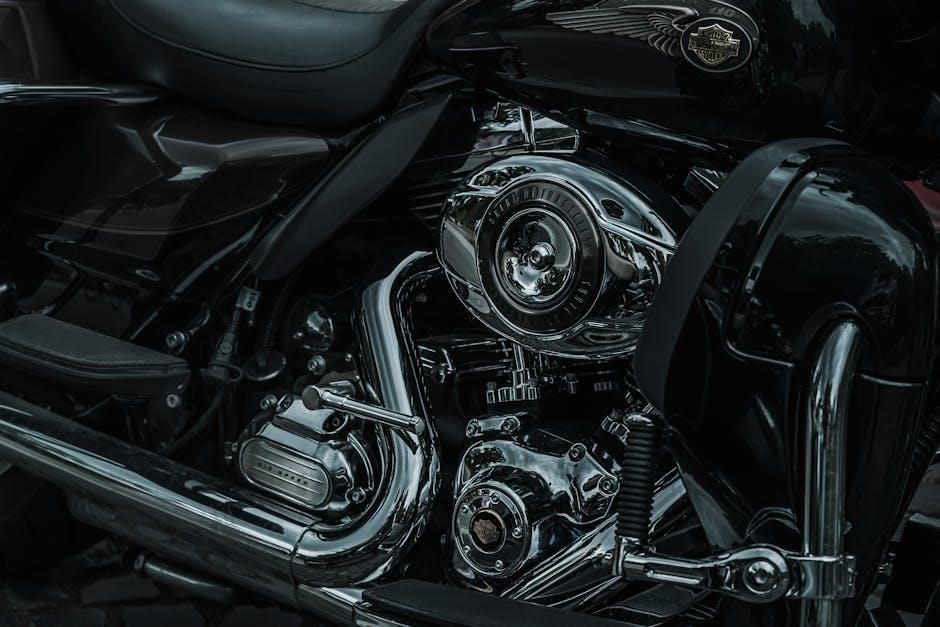
harley davidson parts manual
Harley-Davidson parts manuals are essential resources for owners and technicians, providing detailed information on motorcycle components, tools, and repair procedures to ensure proper maintenance and customization.
Importance of Using Genuine Harley-Davidson Parts
Using genuine Harley-Davidson parts ensures optimal performance, safety, and durability for your motorcycle. These parts are specifically designed to meet the manufacturer’s quality and safety standards, guaranteeing a perfect fit and functionality. Genuine parts are tested to withstand the stresses of riding, reducing the risk of mechanical failure. They also maintain your bike’s warranty and resale value. Counterfeit or aftermarket parts may be cheaper but often compromise on quality, leading to potential safety hazards and costly repairs. By choosing genuine Harley-Davidson parts, you ensure compliance with the manufacturer’s specifications and maintain the integrity of your motorcycle. This is crucial for both routine maintenance and custom upgrades, as outlined in the parts manual.
Overview of the Harley-Davidson Parts Catalog
The Harley-Davidson Parts Catalog is a comprehensive resource designed to help users identify and purchase the correct parts for their motorcycle. It is organized by model and year, making it easy to navigate and find specific components. The catalog includes detailed descriptions, part numbers, and diagrams to ensure accuracy. Whether for routine maintenance, repairs, or custom upgrades, the catalog is an essential tool for any Harley-Davidson owner. It helps maintain the bike’s performance and integrity by providing genuine parts that meet the manufacturer’s standards. Additionally, the catalog is readily available online, allowing users to search and order parts conveniently, reducing downtime and ensuring their motorcycle remains in optimal condition.

Understanding Harley-Davidson Service Manuals
Harley-Davidson service manuals are detailed guides providing instructions for maintenance, repairs, and troubleshooting specific motorcycle models. They are essential for riders and mechanics, ensuring proper handling and performance.
What is a Service Manual?
A Harley-Davidson service manual is a comprehensive guide containing detailed instructions for maintaining, repairing, and servicing specific motorcycle models. It provides step-by-step procedures, diagrams, and specifications to ensure proper handling of components. These manuals are designed for both professional mechanics and DIY enthusiasts, offering clear instructions to diagnose and fix issues. They cover routine maintenance, troubleshooting, and complex repairs, ensuring compliance with manufacturer standards. By following the manual, users can perform tasks efficiently, maintaining the bike’s performance and longevity. It’s an essential resource for anyone working on Harley-Davidson motorcycles, offering model-specific information and expert guidance.
How to Read and Interpret Service Manuals
Reading and interpreting Harley-Davidson service manuals requires a systematic approach. Begin by reviewing the table of contents to understand the manual’s organization, typically divided into sections like engine, transmission, and brakes. Familiarize yourself with diagrams and pictures, which often depict parts from various angles. Look for keys or legends that explain symbols and part numbers. Pay attention to warnings and cautions, as they are critical for safety and preventing damage. Understand torque specifications, referring to the manual for guidance on using a torque wrench to avoid over-tightening. Follow step-by-step procedures carefully, such as removing the oil filter before draining oil to prevent spills. Identify required tools, distinguishing between metric and standard measurements based on your bike’s specifications. Clarify technical terms using a glossary or online resources. Utilize troubleshooting guides systematically, starting with common issues. Practice with simple tasks like oil changes to build confidence. Patience and practice will enhance your ability to use the manual effectively for maintaining your Harley-Davidson.
Types of Service Manuals for Different Harley-Davidson Models
Harley-Davidson service manuals are tailored to specific models, ensuring precise guidance for maintenance and repairs. Softail manuals focus on frame and suspension systems, while Touring manuals emphasize engine performance and electrical systems. Sportster manuals highlight lightweight components and fuel systems. Dyna models have manuals addressing their unique chassis and suspension designs. V-Rod manuals focus on high-performance engines and liquid-cooled systems. Each manual is engineered to match the bike’s specifications, providing detailed diagrams and part numbers. Riders and mechanics can rely on these model-specific guides for accurate troubleshooting and repair instructions, ensuring their Harley-Davidson runs optimally. Understanding the differences in manuals helps in selecting the right one for your bike, making maintenance more efficient and effective.
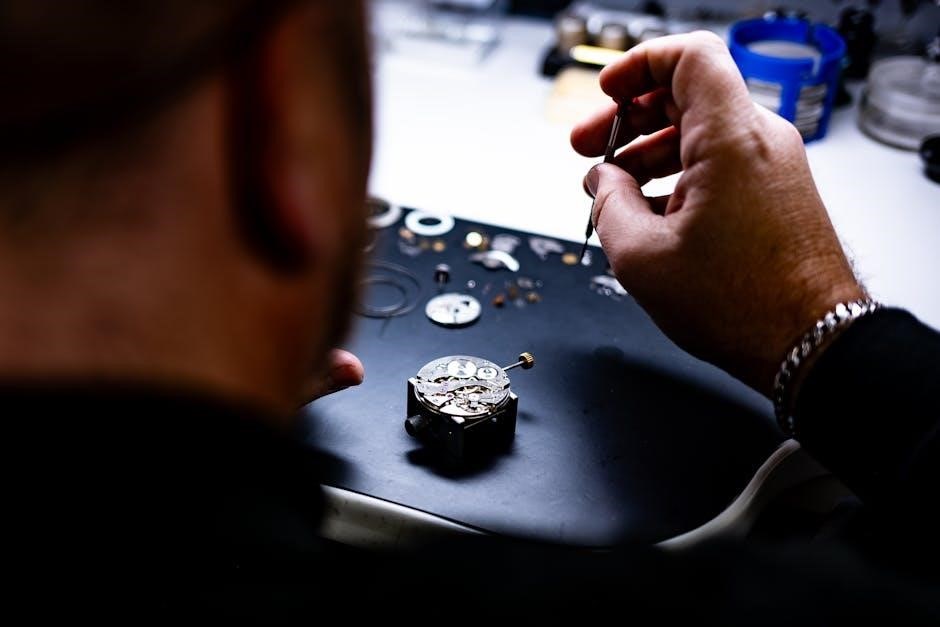
Harley-Davidson Parts Catalogs
Harley-Davidson parts catalogs provide detailed listings of components, including part numbers, diagrams, and compatibility information, essential for repairs, upgrades, and customization across various bike models.
Structure and Organization of the Parts Catalog
The Harley-Davidson parts catalog is meticulously structured to ensure easy navigation and quick access to information. It typically begins with an index section, allowing users to search for parts alphabetically. The catalog is divided into model-specific categories, such as Softail, Touring, or Sportster, each containing detailed diagrams and part lists. Each section is further broken down into subsystems like engine, transmission, electrical, and suspension. High-quality illustrations and exploded diagrams provide visual clarity, while part numbers, descriptions, and compatibility details are listed alongside. This logical organization helps users identify the exact components needed for their specific bike, making repairs and upgrades more efficient. A glossary of terms is often included to clarify technical language, ensuring the catalog is user-friendly for both novice and experienced enthusiasts.
How to Navigate the Online Parts Catalog
Navigating the Harley-Davidson online parts catalog is designed to be intuitive and user-friendly. Start by selecting your specific Harley-Davidson model to filter parts relevant to your bike. Use the search bar at the top to input part numbers or descriptions for quick results. Categories are organized by bike components, such as engine, transmission, or electrical systems, allowing you to browse by section. Interactive diagrams and exploded views provide visual guidance, enabling you to identify parts effortlessly. Filter options let you refine searches by year, model, or part type. Hover over images for part details or click to view specifications. Save parts lists for future reference or share them with mechanics. This streamlined system ensures efficient and accurate part identification, enhancing your repair or customization experience.
Key Features of the Harley-Davidson Parts Catalog
The Harley-Davidson parts catalog offers a comprehensive and detailed resource for identifying and purchasing genuine parts. One of its key features is the ability to search by part number, description, or model-specific categories, ensuring quick access to the components you need. The catalog includes high-quality images and diagrams, providing clear visual references for accurate part identification. It also features model-specific listings, ensuring compatibility with your bike. Additionally, the catalog offers filtering options by year, model, and part type, streamlining your search process. With regular updates, it reflects the latest parts and accessories available. Whether you’re a seasoned mechanic or a DIY enthusiast, the catalog’s intuitive design and detailed information make it an indispensable tool for maintaining or customizing your Harley-Davidson motorcycle.

Using the Harley-Davidson Parts Manual Effectively
The Harley-Davidson parts manual is essential for effective motorcycle maintenance, providing detailed part descriptions, repair guides, and diagrams to help users identify and replace components accurately.
Step-by-Step Guide to Finding Parts
To effectively find parts using a Harley-Davidson parts manual, start by identifying the specific section related to your motorcycle model. Use the index or table of contents to locate the relevant category, such as engine or electrical components. Once you’ve found the section, refer to the detailed diagrams or part number listings. Match the part number from the manual to the component you need. For digital manuals, utilize the search function to quickly locate parts by name or number. Cross-reference the part with the accompanying illustrations to ensure accuracy. Finally, note the required quantity and any associated accessories before ordering or replacing the part.
Understanding Part Numbers and Diagrams
Harley-Davidson parts manuals use specific part numbers to identify components accurately. These numbers are often alphanumeric and correspond to detailed diagrams. Diagrams are typically exploded views showing how parts fit together, making it easier to identify what you need. For example, a part number like “12345-06” refers to a specific component, while the diagram illustrates its location and related parts. Understanding these numbers and visuals helps in ordering the correct items and ensuring proper assembly. Always cross-reference part numbers with the manual’s index or search function to confirm accuracy. This system minimizes errors and saves time during repairs or customizations.
Common Symbols and Abbreviations Used
Harley-Davidson parts manuals utilize a variety of symbols and abbreviations to convey information efficiently. Common symbols include wrenches for repair procedures, torque specifications, and warning icons for cautionary measures. Abbreviations like “LH” (left-hand) and “RH” (right-hand) indicate component locations. Other abbreviations, such as “Nm” for torque measurements, are frequently used. These symbols and abbreviations are standardized across manuals to ensure clarity. They help technicians and DIY enthusiasts quickly identify procedures, specifications, and potential hazards. Understanding these symbols is crucial for accurate repairs and maintenance. Always refer to the manual’s legend or glossary section for a comprehensive guide to these symbols and abbreviations.

DIY Projects with Harley-Davidson Parts Manuals
Harley-Davidson parts manuals empower enthusiasts to tackle various DIY projects, from basic maintenance to complex customizations. They provide detailed guidance, enhancing both functionality and personalization of motorcycles.
Essential Tools for DIY Harley-Davidson Repairs
Having the right tools is crucial for DIY Harley-Davidson repairs. A socket set, combination wrenches, and pliers are fundamental for most tasks. A torque wrench ensures proper bolt tightening, preventing damage. Multimeters are handy for diagnosing electrical issues. Specialized tools like spark plug sockets and tire pressure gauges are must-haves. Safety gear, including gloves and safety goggles, protects during repairs. An air compressor and jack simplify tasks requiring bike lifting. Organize your tools in a chest for easy access. A work light illuminates your workspace. Always refer to your Harley-Davidson parts manual for specific tool recommendations. Investing in quality tools ensures longevity and reliability for your DIY projects.
Popular DIY Projects for Beginners
Beginners can start with simple DIY projects like oil changes, air filter replacements, and basic bolt-on upgrades. Oil changes are straightforward and essential for maintaining engine health. Replacing the air filter improves performance and fuel efficiency. Upgrading to aftermarket exhaust systems or handlebars is also popular for customization. Brake pad replacements are another common project for improving safety. These tasks are relatively easy and build confidence in working with Harley-Davidson motorcycles. Always follow the instructions in your parts manual for guidance. Small modifications and routine maintenance are great ways to familiarize yourself with your bike’s components. Start with these projects to gain hands-on experience and gradually move to more complex tasks as your skills improve.
Advanced Customization Ideas
For experienced enthusiasts, advanced customization projects can transform a Harley-Davidson into a unique masterpiece. Upgrading to a performance engine kit or installing a custom exhaust system enhances power and sound. suspension modifications, such as lowering or raising the bike, can improve handling and aesthetics. Custom paint jobs or powder coating frame components add a personalized touch. Advanced lighting modifications, like integrated LED systems, modernize the bike’s appearance. Installing aftermarket handlebars, grips, or controls enhances ergonomics and style. For tech-savvy riders, upgrading to an aftermarket EFI tuner or custom wiring harness allows precise engine tuning. These projects require skill but offer endless possibilities for creating a one-of-a-kind Harley-Davidson.

Model-Specific Parts Manuals
Model-specific parts manuals provide detailed, precise information tailored to each Harley-Davidson model, ensuring accurate part identification and compatibility for maintenance, repairs, and customizations.
Softail Models: Key Features and Parts
Softail models are renowned for their classic styling and innovative rear suspension design, which mimics the appearance of a rigid frame. The parts manual for Softail bikes provides detailed diagrams and descriptions of components like the hidden rear suspension, engines, and drivetrain. Key features include the Milwaukee-Eight and Evolution engines, as well as customizable options for handlebars, seats, and exhaust systems. The manual also highlights unique parts such as fork tubes, swingarms, and brake systems. By referencing the Softail-specific manual, riders can identify exact part numbers for repairs or upgrades, ensuring compatibility and performance. Regularly consulting the manual helps maintain the bike’s integrity and enhances riding safety and comfort.
Touring Models: Exclusive Parts and Accessories
Harley-Davidson Touring models, such as the Electra Glide, Road King, and Ultra Limited, are designed for long-distance riding, featuring large fairings, ample storage, and advanced infotainment systems. The parts manual for these models highlights exclusive components like batwing fairings, touring seats, and heavy-duty luggage racks. Key parts include high-output engines, precision cooling systems, and specialized suspension setups for load-carrying capacity. Accessories like GPS navigation, heated grips, and premium audio systems are also detailed. The manual provides part numbers and diagrams for maintaining and upgrading these touring-specific features, ensuring riders can optimize their bikes for comfort and performance on extended journeys. This focus on durability and comfort makes the Touring models a favorite among long-distance riders.
Sportster Models: Unique Components and Upgrades
Harley-Davidson Sportster models, including the Iron 883 and Forty-Eight, are known for their lightweight, minimalist design, and versatility. The parts manual highlights exclusive components such as compact Evolution and Revolution engines, sport-tuned suspensions, and sleek fuel tanks. Key upgrades include performance air filters, aftermarket exhaust systems, and adjustable handlebars for improved handling. Customization options like cafe racer kits and scrambler conversions are popular among enthusiasts. The manual provides detailed part numbers and diagrams for maintaining and upgrading these models. Sportsters are also equipped with modern features like LCD infotainment systems in later models. Their durability and ease of modification make them a favorite for both new and experienced riders seeking a balance of style and performance.
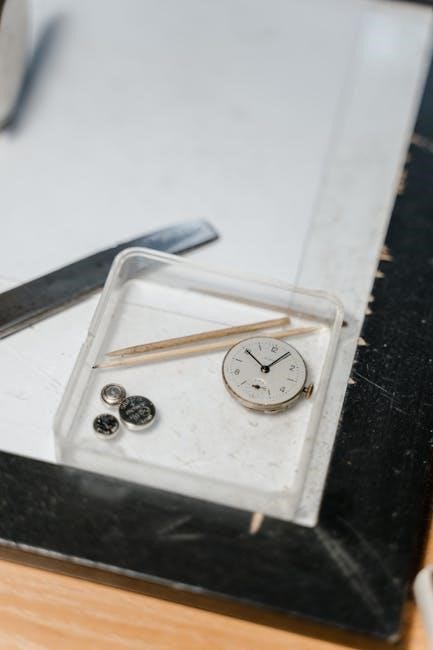
Troubleshooting with Harley-Davidson Manuals
Troubleshooting Harley-Davidson issues becomes efficient with detailed manuals. Diagnostic steps, symptom-based charts, and repair procedures guide users to identify and fix problems quickly and effectively.
Common Issues and Their Solutions
Harley-Davidson manuals address frequent issues like engine stalling, reduced performance, or electrical malfunctions. For instance, stalling may result from faulty spark plugs or clogged air filters. Replacing plugs or cleaning filters often resolves this. Performance drops could indicate carburetor or fuel injection system problems, which manuals guide users to inspect and adjust. Electrical issues, such as dim headlights, are often due to corroded connections or failing fuses. Manuals provide step-by-step instructions to locate and replace faulty components. By following diagnostic charts and repair procedures, riders can identify root causes and apply effective fixes, ensuring their bike runs smoothly and safely. These solutions empower owners to maintain their Harley-Davidson with confidence.
How to Identify Faulty Parts Using Manuals
Harley-Davidson manuals provide detailed diagnostic guides to help identify faulty parts. Start by referencing the symptom-based troubleshooting sections, which link specific issues to potential components. Use the manual’s visual diagrams to locate parts and their connections. Cross-reference part numbers with the parts catalog to verify compatibility. Pay attention to error codes and performance indicators, as manuals often map these to specific failures. Electrical systems can be traced using wiring diagrams, while mechanical issues may require inspecting wear patterns or measuring tolerances. By systematically following the manual’s instructions, riders can pinpoint faulty parts efficiently, ensuring accurate repairs and minimizing downtime. This methodical approach helps maintain bike reliability and performance.
Diagnostic Techniques Using Service Manuals
Harley-Davidson service manuals offer comprehensive diagnostic techniques to identify and resolve issues efficiently. They provide step-by-step procedures for troubleshooting common problems, such as electrical system malfunctions or engine performance issues. Manuals include detailed wiring diagrams, allowing riders to trace and test circuits systematically. Mechanical components can be inspected using torque specifications and wear tolerances outlined in the manual. Diagnostic trouble codes (DTCs) are decoded within the manual, guiding users to specific fault locations. Visual aids like exploded diagrams and flowcharts simplify complex diagnostics. By following these structured methods, riders can accurately diagnose problems, ensuring repairs are both effective and safe. This systematic approach minimizes guesswork and ensures long-term reliability of the motorcycle.
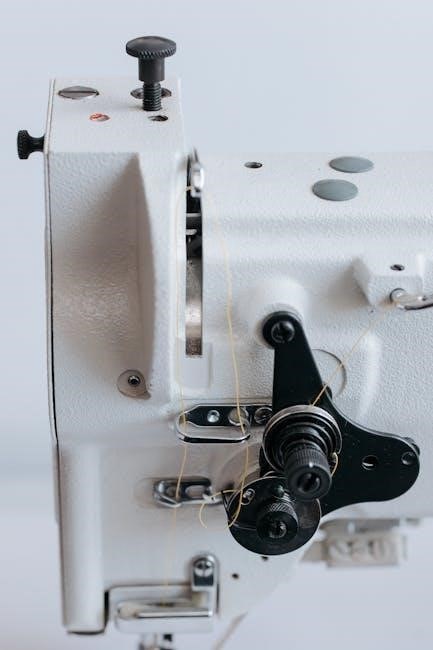
Safety Guidelines for Using Harley-Davidson Parts
Always wear protective gear, including gloves and goggles, when handling parts. Use proper tools to avoid damage or injury. Follow torque specifications and manual instructions carefully.
Importance of Following Safety Instructions
Importance of Following Safety Instructions
Adhering to safety guidelines is crucial when working with Harley-Davidson parts to prevent accidents and ensure proper repairs. Failing to follow instructions can lead to personal injury or motorcycle damage. Always wear protective gear, such as gloves and safety glasses, to minimize risks. Proper tool usage is essential, as incorrect tools can damage parts or cause injuries. Ensure all repairs are done in a well-ventilated area, away from flammable materials. Strictly follow torque specifications and assembly procedures outlined in the manual to maintain motorcycle performance and safety. Ignoring safety protocols can result in faulty repairs, leading to dangerous riding conditions. Safety should never be compromised, even for experienced riders or mechanics.
Precautions When Handling Harley-Davidson Parts
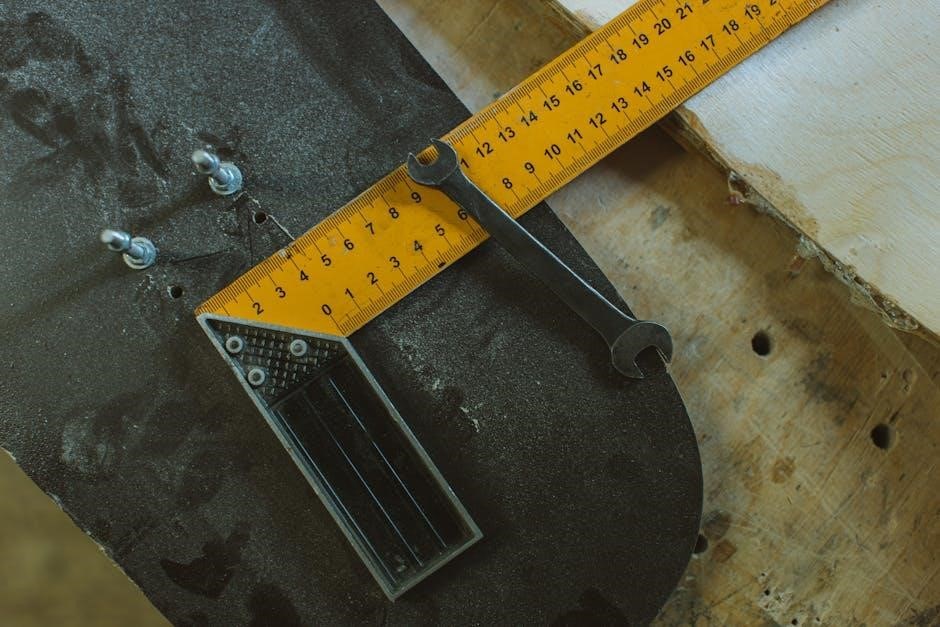
Handling Harley-Davidson parts requires careful attention to avoid damage and ensure safety. Always inspect parts for any visible defects or wear before installation. Use clean, dry gloves to prevent oils from your skin from contaminating components. Avoid touching sensitive surfaces, such as gaskets or seals, as fingerprints can compromise their performance. Store parts in a cool, dry place, away from direct sunlight or extreme temperatures. Never force-fit components, as this can cause irreversible damage. Use soft, padded surfaces to lay out parts during repairs to prevent scratching. Keep loose parts organized to avoid misplacement or mixing with other models. Proper handling ensures parts function as intended and maintains the integrity of your motorcycle.
Best Practices for Safe Repairs and Maintenance
Adhering to best practices ensures safe and effective repairs when working with Harley-Davidson parts. Always start by consulting the official service manual for specific instructions tailored to your model. Wear protective gear, including gloves, safety glasses, and a face mask, to minimize risks. Ensure the motorcycle is on a stable stand and the engine is cool before beginning work. Disconnect the battery to prevent accidental startups. Use approved tools to avoid damaging components. Follow torque specifications precisely to prevent over-tightening or loosening of fasteners. Test components gradually after reassembly to identify any potential issues. Regularly clean and maintain tools to ensure accuracy. By following these practices, you safeguard yourself and maintain the reliability of your Harley-Davidson.

Resources for Harley-Davidson Parts Manuals
Official Harley-Davidson websites provide access to genuine parts manuals. Online communities and forums offer valuable insights and support. Authorized dealerships ensure authenticity and expert guidance.
Official Harley-Davidson Websites and Portals
Harley-Davidson provides official online platforms for accessing parts manuals. The Harley-Davidson official website offers a dedicated section for parts and accessories. Users can explore the Harley-Davidson Parts & Accessories Catalog, which is regularly updated. These portals allow enthusiasts to search for specific parts by model year, bike type, or part number. They also feature interactive diagrams and detailed descriptions. The official Harley-Davidson Service Information Portal is another valuable resource, catering to both DIYers and professionals. It ensures access to genuine and accurate information, maintaining safety and performance standards. Regular updates guarantee compatibility with the latest models and technologies. These official resources are essential for anyone working on a Harley-Davidson, ensuring reliability and authenticity in every repair or customization project.
Online Communities and Forums for Support
Online communities and forums dedicated to Harley-Davidson enthusiasts provide invaluable support for parts manual-related inquiries. Platforms like Harley-Davidson Forums, HDForums, and Harley-Davidson Subreddit are hubs for discussing parts, repairs, and customizations. Members share experiences, offer troubleshooting tips, and provide guidance on using parts manuals effectively. Many forums include sections for DIY projects, where users can find step-by-step guides and part recommendations; Additionally, Facebook groups like Harley-Davidson Owners and Enthusiasts foster collaboration and knowledge exchange. These communities often feature live chat options, allowing real-time interaction with experts. By engaging with these forums, riders can gain insights, resolve issues, and connect with like-minded individuals, enhancing their ability to use parts manuals confidently and efficiently for maintenance and modifications.
Authorized Dealerships for Genuine Parts
Authorized Harley-Davidson dealerships are the most reliable sources for genuine parts, ensuring quality and compatibility with your motorcycle. These dealerships have access to the complete parts catalog, allowing them to provide exact-fit components tailored to your specific model. Their knowledgeable staff can offer expert advice, helping you navigate the parts manual and find the right items for maintenance, repairs, or customizations. Additionally, purchasing from authorized dealers guarantees warranty coverage and adherence to Harley-Davidson’s quality standards. Many dealerships also provide online ordering options, making it convenient to acquire parts directly from their inventory. By supporting authorized dealers, riders ensure they receive authentic products that meet the brand’s reputation for durability and performance, maintaining their bike’s integrity and value over time.